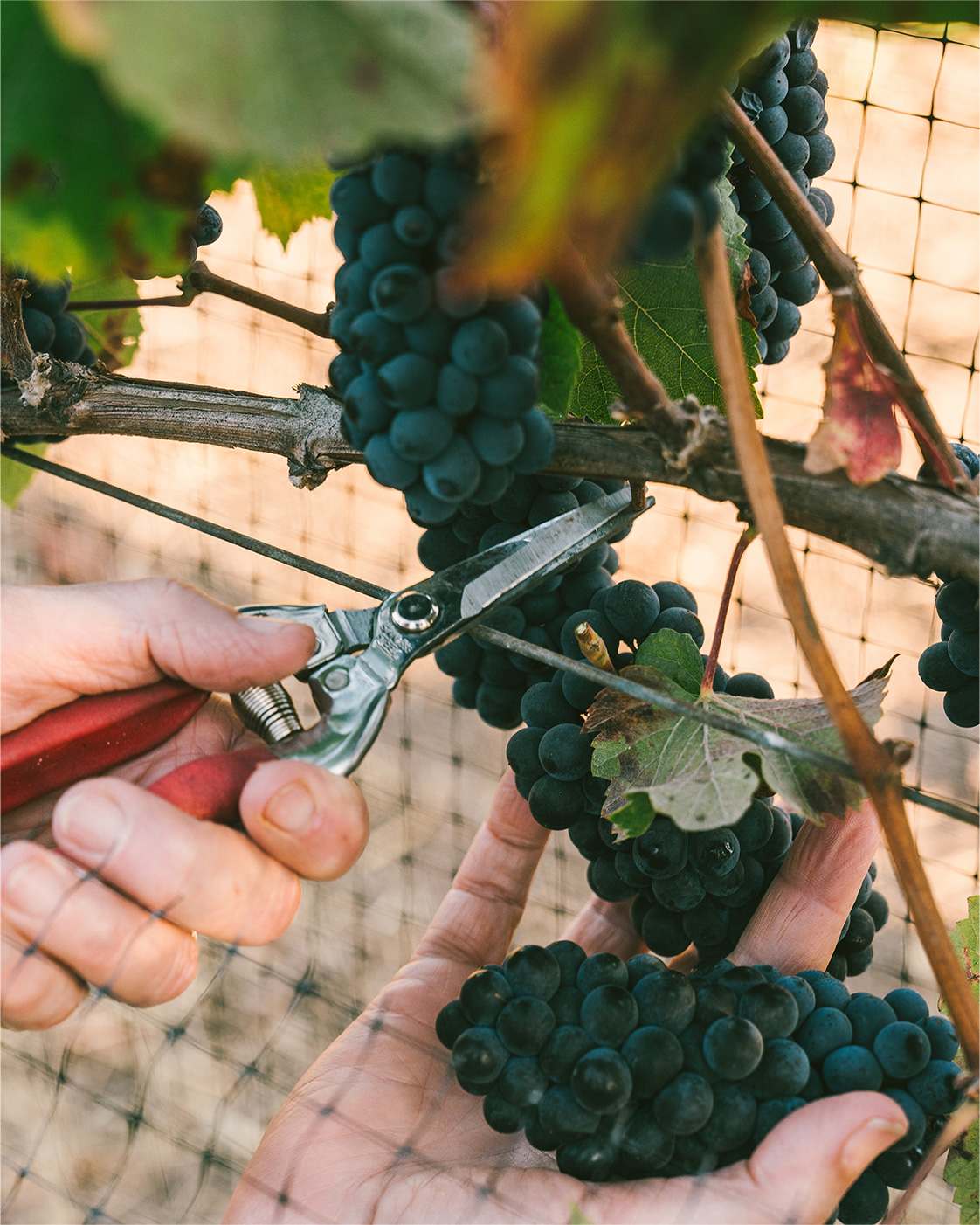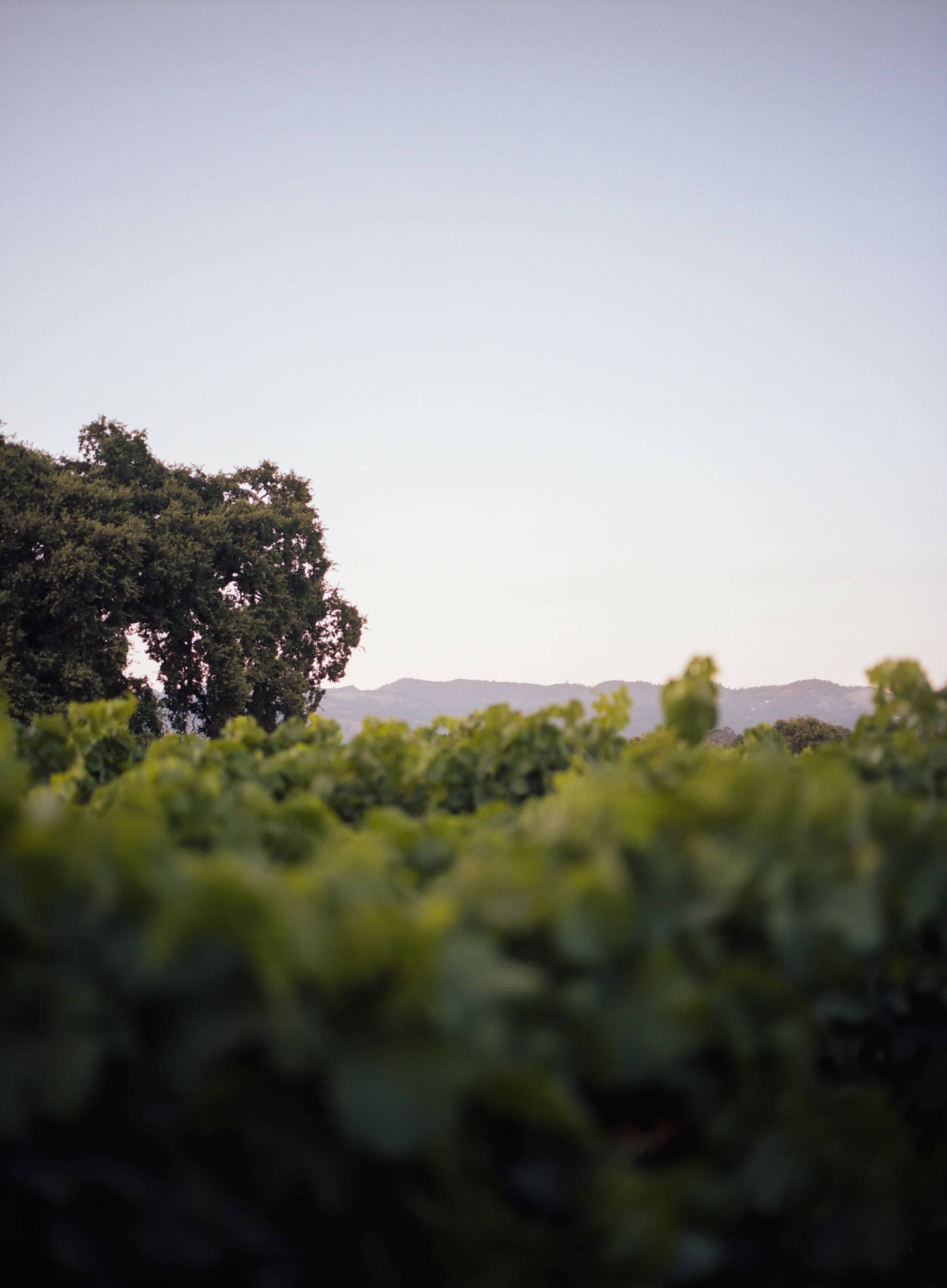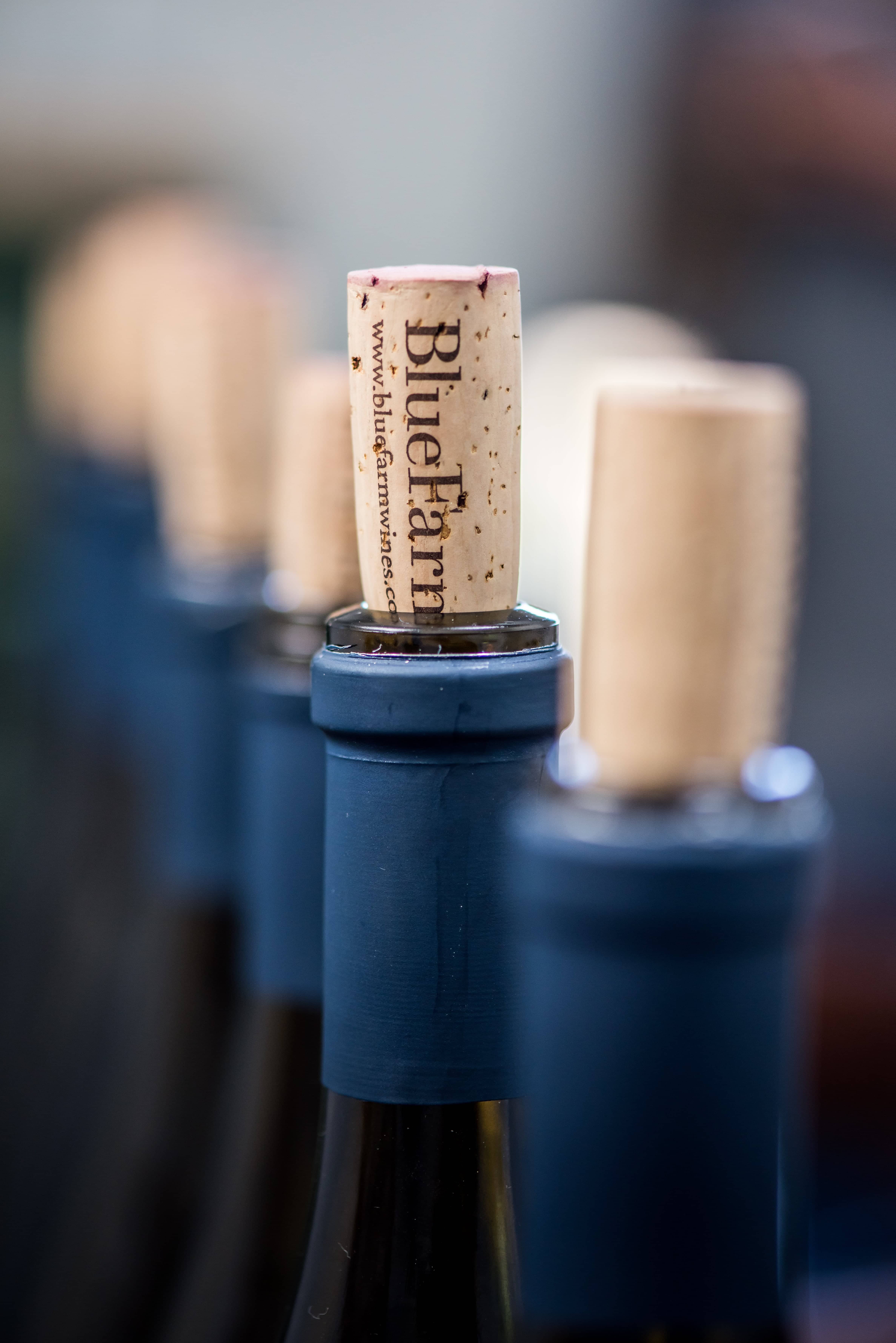Farming
Planting the right clone(s) – particularly with Pinot Noir – in the right place is a necessity for making a whole and seamless wine. However, tight decision making and quality practices also contribute incrementally throughout the growing season.

| Site |
Site is the determining factor for the growing of great wines. All of the characteristics of a given place – including soil, elevation, exposure, slope, and climate – determine how a grape, clone, or selection will perform there. |
|---|---|
| Precise Farming |
Precision farming is hands-on; we touch each vine at least nine times. The vintage begins with the first pruning cut during winter dormancy. We average six buds per cane and adjust to each individual vine. We begin suckering when the shoots are two inches long to eliminate doubles. Shoots are thinned and positioned and trellis wires moved early and often to accommodate winds, particularly in Carneros. Depending on the size of the shoot, we leave one or two clusters. We thin leaves by hand on the north side of the row to aid airflow. We remove wings from clusters to prevent uneven ripening. We make a pass through the vineyard to prevent clusters from touching. As veraison (when berries soften and color) approaches 95%, we drop green fruit to ensure uniformity. The vintage ends with a powerful decision – when the vineyards want to be harvested. We walk each block frequently to track its progress. Once we decide, we hand-pick and hand-sort the fruit. Water is the ultimate vineyard management tool and the judicious application of water provides the winegrower with a vital tool. Used wisely, water maintains vine health, regulates vigor, assures continuity of ripening, and prevents dehydration. |
| Ripeness |
Uniform ripeness is essential, and the work must be done early and often. Unevenly ripened fruit at harvest results in a disjointed wine with both syrupy overripe and green under ripe features. For uniform ripeness, we treat vines on the same soils the same way, recognizing naturally similar units and farming accordingly. A unit can be a block, sub-block or small part of a sub-block within a single vineyard. We begin at pruning by leaving just enough buds to bring a vine into balance, and we monitor and adjust each vine throughout the growing season. This approach is custom-tailored rather than one-size-fits-all winegrowing. |
Vineyards
Occasionally, all the elements that define a place – soil, terrain, climate – come together harmoniously at one special site. Decades of experience and close attention to detail enable us to identify these places, tailor vineyard design, plant materials, and use precise farming for each cru.

| Anne Katherina Vineyard |
Blue Farm takes its name from the blue farmhouse at Anne Moller-Racke’s home in Carneros. The vineyard there is called Anne Katherina. In 2001, Anne originally planted seven acres of Pinot Noir divided into four blocks dedicated to the Swan selection and three Dijon clones. The vineyard has now been divided to create multiple Pinot Noirs from the same site. The Anne Katherina Estate Pinot Noir is made up of the Swan selection, Dijon 115, and Dijon 667. The Farmhouse Pinot Noir consists of only the Roederer selection. More recently we have grafted over the Calera selection to create the Riverbed Pinot Noir and at the same time we also added Old Wente to make an Estate Chardonnay. Closest Town: Downtown Sonoma; AVA: Carneros; Varietal: Pinot Noir; Planted: 2001; Clone(s): Swan, Dijon 115, 667 Varietal: Chardonnay; Grafted: 2016; Clone: Old Wente; Rootstock: 101-14; Soil Type: Gravely clay loam; Aspect: Flat; Row Orientation: East/West. |
|---|---|
| 1861 Vineyard |
This vineyard is named both for its street address and coincidentally for the year in which Agoston Haraszthy was appointed by California's governor to "promote the improvement and growth of the grapevine" in the state. 1861 vineyard is planted on a plateau in the hills a thousand feet above the Sonoma plaza. Less than half an acre, the small site divides itself naturally into two blocks, one rockier than the other. The site is planted to the Pommard clone on 101-14 rootstock with a narrow spacing of 4' x 5'. The Pacific Ocean and San Pablo Bay provide a marine influence of foggy mornings, which allow the delicate Pinot Noir to thrive in this rugged hillside setting. |
| King Ridge Vineyard |
King Ridge vineyard is tucked away on the northwestern reach of the Sonoma Coast. At 1100 feet elevation and 5 miles inland from the Pacific Ocean, the AVA is Fort Ross-Seaview. We are excited to be working with 2 acres of this spectacular vineyard. The vineyard is superbly farmed with tightly spaced vines on Goldridge soil; creating wines that have tension and richness, as well as balance and edginess. Closest Town: Cazadero; AVA: Fort Ross-Seaview; Varietal: Pinot Noir; Planted: Early 2000s; Clone(s): Pommard & Bacigalupi; Rootstock: 420 A & 3309; Soil Type: Goulding Series; Aspect: Bacigalupi and Pommard/ East Sloping; Row Orientation: East / West. |
|
Gap’s Crown VineyardStarting in 2019
|
Gap’s Crown is one of the highly acclaimed Sonoma Coast vineyards. Perched on the western edge of Sonoma Mountain at 840 feet above sea level, the vineyard takes advantage of the steep Sonoma Mountain hillside. We have two Pinot Noir blocks that complement each other and add complexity to the wine. The 667 block is on the northern part of the vineyard where it is west facing at higher elevation. This selection brings great perfume and flesh to the blend. The 777 block is close to the south east corner of the vineyard on gravely clay loam. The tiny berries are the backbone, giving the wine its structure. Closest Town: Petaluma; AVA: Sonoma Coast; Varietals: Pinot Noir; Planted: Early 2000s; Clone(s): Dijon 667 & 777 - Pinot Noir; Rootstock: Riperia Glorie; Soil Type: Brown Clay Loam & Goulding Series; Row Orientation: East/West. |
| Laceroni Vineyard |
Planted in the mid 2000’s, Laceroni vineyard is nestled in the deep south western part of the Russian River Valley close to the town of Graton. The cool climate and typical Goldridge soil give this wine its character. Protected from direct sunlight with soft rolling hills, this site allows for slow ripening. Meticulous farming, combined with a great site are the recipe for a beautiful wine. Closest Town: Graton; AVA: Russian River; Varietal: Chardonnay; Planted: Mid 2000s; Clone(s): Dijon 95; Rootstock: 3309; Soil Type: Goldridge; Aspect: Slightly western facing; Row Orientation: East/West. |
Winemaking
We believe the winemaker should be as comfortable in the vineyard as the winegrower is at home in the cellar. We focus on the vineyard in lieu of being manipulative in the winery so that our wines truly express what the site and vintage offer.

